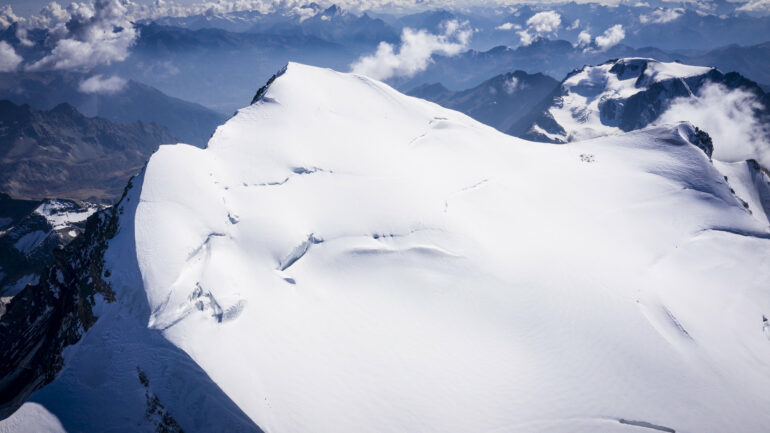As part of the Ice Memory initiative, Paul Scherrer Institute (PSI) researchers, with colleagues from the University of Fribourg and Ca’ Foscari University of Venice as well as the Institute of Polar Sciences of the Italian National Research Council (CNR), analyzed ice cores drilled in 2018 and 2020 from the Corbassière glacier at Grand Combin in the canton of Valais.
Now a comparison of the two sets of ice cores, published in Nature Geoscience, shows that global warming has made at least this glacier unusable as a climate archive.
Reliable information about the past climate and air pollution can no longer be obtained from the Corbassière glacier in the Grand Combin massif, because alpine glacier melting is progressing more rapidly than previously assumed. This sobering conclusion was reached by researchers led by Margit Schwikowski, head of the Laboratory for Environmental Chemistry at PSI, and Carla Huber, Ph.D. student and first author of the study, when they compared the signatures of particulate matter locked in the annual layers of the ice.
Glaciers are invaluable for climate research. The climatic conditions and atmospheric compositions of past ages are preserved in their ice. Therefore, they can serve—in much the same way as tree rings and ocean sediments—as a so-called climate archive for research.
Normally, the amount of particle-bound trace substances in ice fluctuates with the seasons. Substances such as ammonium, nitrate, and sulfate come from the air and are deposited on the glacier through snowfall; the concentrations are high in summer and low in winter, because lower amounts of polluted air can rise from the valley when the air is cold.
The 2018 ice core, which was drilled from depths of up to 14 meters during a preliminary study and contains deposits dating back to 2011, shows these fluctuations as expected. But the core from 2020, from a depth of up to 18 meters—drilled under the leadership of PSI researcher Theo Jenk—shows those fluctuations only for the upper three or four annual layers. Deeper in the ice—that is, farther in the past—the curve indicating the concentration of trace substances becomes noticeably flatter, and the total amount is lower. Schwikowski’s team reports on this in their study.
Washed away by meltwater
Their explanation for the observed discrepancy: Between 2018 and 2020, the glacier melting must have been so strong that an especially large amount of water from the surface penetrated into the glacier and carried the trace substances it contained into the depths.
“But apparently the water there did not freeze again, concentrating the trace substances,” the environmental chemist concludes, “but instead it drained off and literally washed them away.” Of course, that distorts the signatures of the layered inclusions. The climate archive is destroyed. It is as if someone broke into a library and not only messed up all the shelves and books, but also stole a lot of books and mixed up the individual words in the remaining ones, making it impossible to reconstruct the original texts.
The researchers examined the meteorological data from 2018 through 2020. Since there is no weather station at the top of the Grand Combin, they combined data from the surrounding stations and extrapolated it for the study area on the mountain. According to this calculation, it was warm on the glacier in line with the general climatic trend, but these years were not extreme outliers.
“From this we conclude that there was no singular trigger for this strong melting, but that it resulted from many warm years in the recent past,” Schwikowski says. “It seems a threshold has been crossed, which now has led to a comparatively strong effect.”
Unexpected dynamics
The bottom line is that the example of the Grand Combin shows that the melting of glaciers is progressing more dynamically than experts had assumed.
“For a long time it has been clear that the glacier tongues are retreating. But we would not have thought that the areas feeding high alpine glaciers would also be so severely affected—that is, their highest part, where the ice replenishment is formed,” says Schwikowski.
So far, the researchers have examined the distribution of oxygen isotopes in the ice, which can provide information about temperature developments, and of ionic trace compounds such as ammonium, nitrate, and sulfate. Next they want to analyze to what extent the signatures of organic substances in the ice are also affected.
Ice Memory: Ice core sanctuary in Antarctica
Another reason Schwikowski is interested in this is because together with other ice core experts from around the world, she is involved in the initiative led by the Ice Memory Foundation. The aim of this research effort is to obtain ice cores from 20 endangered glaciers around the world in 20 years and collect them in a global climate archive. The cores, cut into rods around one meter long and eight centimeters in diameter, which were individually



